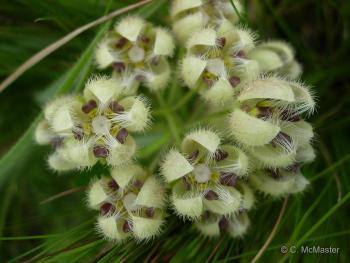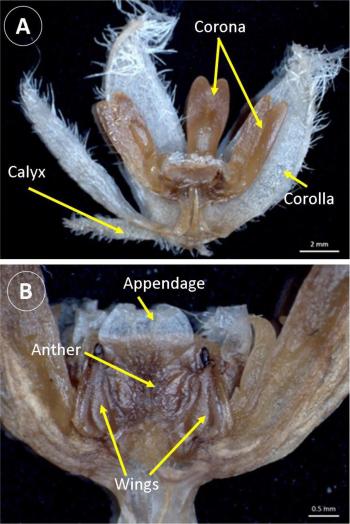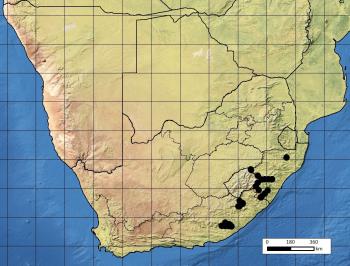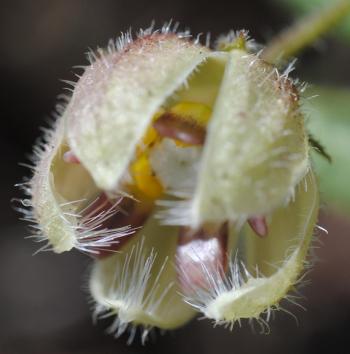Fanninia caloglossa
Fanninia caloglossa Harv.
Family: Apocynaceae
Common names: Fannin’s beauty
Introduction
This monotypic genus (containing only one species) and despite its small stature, is very pretty. It was mentioned by the well-known botanist N.E. Brown, more than a hundred years ago, that it is well worth cultivating because of its intriguing and pretty flowers, but since, it has escaped cultivation and may be a good subject for someone ready for a challenge.

This monotypic genus has a few outstanding characters that warrant it being in a genus of its own. The stipitate gynostegium and segmented hairs being some of the most outstanding features. In the phylogeny, this taxon clustered with a number of species of Asclepias, is very interesting and found growing in midland or highland mountain grassland, often in annually burned areas. N.E. Brown (1908) says: ‘This is one of the most beautiful of South African Asclepiads…’. It is a delicate and most attractive plant (fig. 30), and anyone who has encountered this species, whether in the field or herbarium, has to concur with Brown’s statement.

Description
Description
Perennial, geophytic herb 100–250 mm high, with tuberous thickened roots. Stems usually solitary, covered in white hairs. Leaves spreading to erect, in 2 or opposite 3 pairs; lamina ovate to narrowly lanceolate, 25–60 × 4–25 mm.
Inflorescences solitary, at the end of stems, in nodding, lax umbels that are 4(–8)-flowered; pedicels and peduncle noticeably long, 19–60 mm. Flowers creamy lilac with faint purple veins.

Corolla lobes erect, oblong-lanceolate, 7.0–14.5 × 4–7 mm, fused at the base; outside surface with long, white-villous hairs (especially toward the tips of the segments), inside somewhat glabrous. Staminal column short, 4.2 mm high, stipitate. Corona purple-black; lobes erect, oblong, much overtopping style-stigma apex, 5–6 mm high, ± 2.5 mm wide, apex truncate, 2 white appendages at base curving over style-stigma-head. Anther suborbicular, incumbent on style-stigma-head. Flowering time is early summer, from November to January, peaking in December.

Conservation Status
Status
This species has been assessed as Least Concern(LC) (Victor & Nicholas 2004), despite it being very rare due to mainly its wide distribution range. Its recorded patchy distribution can possibly be attributed to being an under-collected taxon.

Distribution and habitat
Distribution description
Fannin’s beauty is restricted to South Africa (Eastern Cape & KwaZulu-Natal), althouth it must still be ascertained if it also occurs in Lesotho. It is found in grasslands in the highlands of the Drakensberg, or the midlands on mountain islands, in annually burnt areas; at altitude 750–2 500 m.
Derivation of name and historical aspects
History
The generic name Fanninia was given in recognition to G.F. Fannin (1832–1865), who was an avid collector of plant specimens, who farmed in 'The Dragle’ area of KwaZulu-Natal, from 1847–1865. The species name comes from the combination of the Greek words calo, meaning ‘beautiful’ and glossa, that means ‘tongue’. The genus consists of only this one species, but it is allied to other members of the Schizoglossum complex, that include amongst others the genera Cordylogyne, Periglossum and Schizoglossum.

Ecology
Ecology
It has been reported that plants are pollinated by beetles. The small stature of the plants makes them difficult to find in the wild and this is possibly the main reason why so little is known on their pollination and ecology.
Uses
Use
Literature is lacking of information on both their use for medicine, food or other use in cultural activities. If seed could be found it would make an interesting and perhaps challenging ornamental subject to grow.

Growing Fanninia caloglossa
Grow
As far as could be established, this plant is not grown in cultivation. No positive herbarium records of its fruit exist, but if this could be obtained it would make for a difficult subject to grow, as no information on its cultivation is available. Best practise for growing indigenous species is to try and stimulate the natural growing conditions, which in this case, is frequent watering and growing seed in a medium with high organic content. Because of the species having a tuberous rootstock, it would probably make a good subject for a container plant.
References
- Brown, N.E. 1907. Krebsia. Flora capensis. 530-531.
- Glen, H.F. & Germishuizen, G. (compilers). 2010. Botanical exploration of southern Africa, edition 2. Strelitzia 26. South African National Biodiversity Institute, Pretoria.
- Leistner, O.A. (ed.). 2000. Seed plants of southern Africa: families and genera. Strelitzia 10. National Botanical Institute, Pretoria.
- Nicholas, A. (1999) A taxonomic reassessment of the subtribe Asclepiadinae (Asclepiadaceae) in southern Africa. Ph.D. thesis (unpublished), University of Durban Westville, pp. 608–624.
- Pooley, E. 2005. A field guide to wild flowers KwaZulu-Natal and the eastern regions. The Flora Publications Trust, Durban.
- Victor, J.E. & Nicholas, A. 2004. Fanninia caloglossa Harv. National Assessment: Red List of South African plants version 2012.1. Accessed on 2012/09/06.
Credits
Stoffel Petrus Bester
National Herbarium, Pretoria
January 2017
Plant Attributes:
Plant Type: Perennial
SA Distribution: Eastern Cape, KwaZulu-Natal
Soil type: Loam
Flowering season: Early Summer
PH:
Flower colour: Green, Pink, Cream
Aspect: Full Sun
Gardening skill: Challenging
Special Features:
Horticultural zones








Rate this article
Article well written and informative
Rate this plant
Is this an interesting plant?
Login to add your Comment
Back to topNot registered yet? Click here to register.